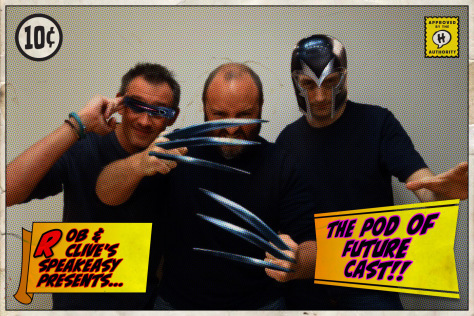Rob Wickings's Blog, page 57
June 25, 2014
Fodderblog: Bruges
You will struggle to go hungry on a visit to Belgium. There's just too much on offer.
Belgians love good food; I'm told that, apart from their cars, eating out is what they spend their money on. And yet, somehow, it's looked upon as a place where all there is to eat is frites and mayo, and mussels.
That does the country a tremendous disservice. Although it isn't hard to find a frituur if you want a quick snack (and the Belgians treat the frite with such reverence that there's even a museum dedicated to the humble chipped potato in Bruges) there's a head-spinning variety of eats on offer. Bruges itself, a tiny town of less than 200,000 citizens, has 400 restaurants, including a Michelin-starred joint. There's something for every taste and budget.
The humble mussel is a big part of Belgian cuisine, but it's offered in many different ways. From the classic wine and sweet aromatic base, to curry and cream, to steamers in a local beer, there's nothing more pleasant than a huge pot of mosselen — with frites to dunk in the sauce, of course. But bear in mind that seafood is a must in Belgium too. Bruges is a ten-minute train ride from the sea port of Ostend, and features a daily fish market. It's worth spending the extra on the catch of the day, because it won't get much fresher.
Belgians are great believers in the restorative qualities of a huge slab of meat. Their cows produce beef that is sweet, dense and deeply flavoured. The steaks on offer at even the humblest restaurant are thick and juicy. Bear in mind that they view the notion of 'well-done' with deep suspicion. It's worth ordering your steak a step or two more cooked than you'd usually like it — medium-rare will be bloody as hell.
Chicken, however, is looked upon as a bit of an oddity to the Belgian palate — not quite meat or fish. You'll tend to find it in grill-restaurants like the brilliant, eccentric Arthies (the ribs come in a fiery dry rub with garlic butter on the side, and it's worth having one of their Death's Head beers to cool the fire, served up in skull-glasses) that specialise in chicken and ribs, but it's unlikely that Nandos will be opening up in Belgium any time soon. It's the same with burgers. Quick seems to cater exclusively to tourists, and a gourmet burger joint is getting ready to open in a quiet square a five-minute walk from the Markt, but that's about it. The Belgians don't want to mess around with their meat. Wipe its bum, slap it on a griddle and tuck in. 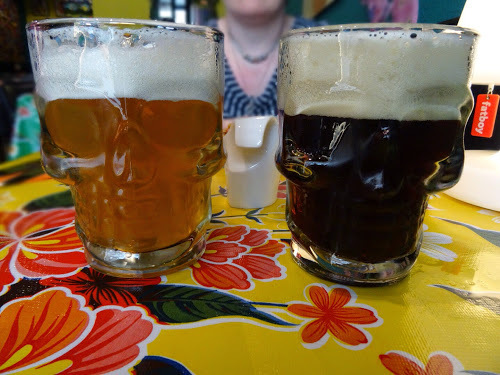 The Death's Head beer at Arthies. What a way to go...
The Death's Head beer at Arthies. What a way to go...
The one exception to that rule is the slow-cooked beef stew known as carbonnade Flammande. This unctuous concoction is braised in a local beer (which means that the flavour of the dish varies from region to region) for hours, before being served with the inevitable frites to mop up the gravy. There's no fat or gristle, just meat that falls gently apart at the touch of a fork. You can find it everywhere, and you really should try it. Food and beer pairings are nothing new in Belgium, of course, and restaurants like Den Dyver specialise in cooking with beer, and offering the perfect brew to drink alongside.
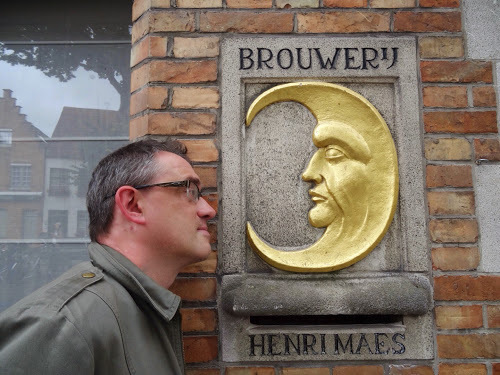 Rob contemplates the future... which clearly contains beer.
Rob contemplates the future... which clearly contains beer.Let's talk a little about beer, the other Belgian obsession. There are 1200 distinct brews from a good few hundred breweries. It's a bewildering choice, made even more so when you consider that each beer comes with it's own branded glass, some so fancy that you'll have to pay a deposit (or leave a shoe behind the bar) if you want to try them. It's very easy to become a beer nerd in Belgium — in fact it's almost a crime in my eyes to stick to Jupiler on tap or, god forbid, Stella Artois. From thick, dark Trappist dubbels or tripels to a bright, sharp wild-fermented gueuze, there's very little chance that you'll repeat yourself. If you're in Bruges, it's worth visiting De Halve Maan (Half-Moon) Brewery to try Bruges Zot, the most local of local brews. Although most bars in the town sell it, the brewery bar is the only place that will sell Zot on tap and unfiltered — and it's cheaper there too.
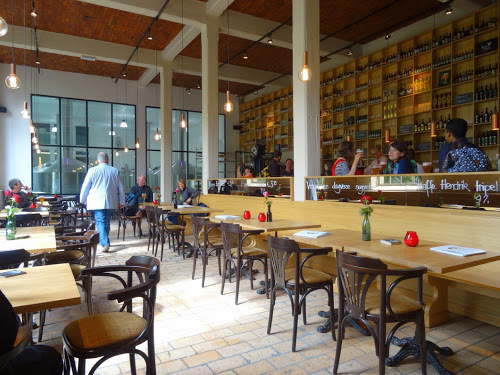 The bar at De Halve Maan.
The bar at De Halve Maan.
If you want to check out the full, dizzying range, get yourself to the basement of the 2Bshop, where four rooms are stocked floor to ceiling with everything from Aardbeien Lambic to Zulte Oude Bruin. At the beginning, I mentioned that you're unlikely to go hungry in Belgium — you're even less likely to go thirsty.
It would be foolish to write about food in Belgium and not mention chocolate. In Bruges it seems as if some shopping streets are almost exclusively dedicated to shops selling the stuff. It's worth noting, though, there are only a few shops that actually make chocolate on the premises. One, The Chocolate Line, supplies sweets to Heston Blumenthal, and outré flavour combinations like bitter Coca-Cola and cannabis are there for the taking. However, it's always packed and very pricy. You're better off checking out Pralinette, whose 'fine and noble chocolates' pack a real punch of flavour without hammering the wallet. I snagged a chunk of cooking chocolate as well — well, it's what I do, isn't it?
Our four days in Bruges covered a full range of culinary experience, from posh to funky mid-price to frites, eaten on a bench. We didn't have a mouthful of duff, poor quality food. If you're a foodie, you owe it to yourself to spend a weekend in Bruges, Brussels or Antwerp. Your diet and wallet might not thank you afterwards, but it's one hell of a ride while it lasts.


June 23, 2014
The Pod Of Future Cast!
X-Men: Days Of Future Past. You’ve read the book. You’ve seen the film. Now hear the podcast!
Rob and Clive are joined by comic fan and Wolverine lookalike Graham Williams as we go in-depth and full-bore into the Claremont/Byrne classic. Remember: in this episode, everybody dies!*
*disclaimer: no-one dies in this episode.


June 17, 2014
Sorbet Colonel
Last night, I finished my meal with a refreshing, traditionally Flemish dessert: Sorbet Colonel. It's light, simple, and surprisingly easy to recreate at home.
Take a chilled ice cream glass, one of those flutey numbers that looks like a frilled petticoat in motion. Half fill it with vodka. Top with two scoops of lemon sorbet. Eat, feeling the chill of the ice play enticingly against the burn of the raw alcohol. You'll end up with a cold slurry of molten sorbet mix and vodka in the bottom of the glass. It's perfectly acceptable to drink this off while loudly declaiming a toast to The Colonel, whoever he may be. Well, I hope it's acceptable, because that's what we did.
Greetings from Bruges, where booze is part of the culture, history and religion of the city, as well as being the national sport. Sköl!


June 13, 2014
In Bruges
Next week, Excuses and Half Truths will be reporting from Belgium. A place where cultural boundaries blur and blend, a hub of European commerce, trade and co-operation.
We'll be looking at the culture and Art Nouveau architecture of historic Bruges and paying a visit to stunning, medievel Ghent. In the interests of our Fodderblog fans, we'll sample the best food and drink that Belgium has to offer. There's more to the place than beer and sausages, you know. Although I am looking forward to the beer and sausages.
We'll also take a look at the rich art scene in Bruges, home of the master of surrealism Rene Magritte. And it wouldn't be Excuses And Half Truths without a focus on one of Belgium's great passions: comics. From the birthplace of Hergé, how could it be otherwise?
Join us, whydoncha, and TLC and I take a week off… in Bruges!


June 11, 2014
Mobile Casino Games: A shift in the gaming demographics
The following article is a guest post.
A new generation of young professionals has changed the way the gaming industry works. Aside from revolutionizing the industry with fresh ideas and concepts, they as consumers are also starting a shift in the demographics for a lot of games, especially in the social casino genre. Before the dawn of casinos for the mobile platform, casino gaming was strictly confined to a certain age group. But as the PlayStation generation entered the professional world, their taste for games changed as well—and gaming developers are lining up just to get the biggest slice of the cake.
In a report by Super Data Research, the $2.9-billion industry became one of the fastest growing segments of the digital gaming industry. According to their research, the growth is attributed to the emergence of younger players to the once highly saturated niche gaming enterprise. AppTopia, a smartphone application analytics firm, said that the former target demographics of social casino games is the 35-50 age bracket divided equally among male and female players.
So what changed the landscape of social casino gaming? What paved way for players aged 21 and up to join a previously uncharted territory?
According to Zoe Mavrofora, Marketing Manager for Lazyland, social casino games’ biggest draw to younger players is the social aspect of the game. “This provides users with all the tools and applications they need in order to play, share, communicate and have fun, whilst drastically increasing user loyalty through constant activity. The main advantages are in reaching a wider, younger audience, creating revenues from user in-game spending and activating word of mouth and viral effect advertisement mechanisms,” Mavrofora said.
Christopher Palmeri of Businessweek said that social casino games heavily borrowed elements from the console gaming industry “to reach beyond its core customer—women 55 years old and up—to a younger demographic.” One notable example is IGT’s Avatar, which uses assets such as 3D animations. The gaming manufacturer, which worked closely with the likes of Pocket Fruity operator Gaming Realms and the Bellagio, goes beyond the usual casino experience and tries to make the games as immersive as possible.
The social gaming industry is expected to become bigger by the end of 2015. While social casino games have already penetrated the younger market, consistency is the key to stay relevant in a volatile market like the social casino industry.



June 9, 2014
Keep Yourself Alive: Rob’s Tao Of Coffee
Coffee: the most important meal of the day.
If I was offered a stark and uncomfortable choice—give up on my morning cup of java or lose one of my little toes—I'd have to think long and hard. But you, know, screw it. I never use l'il pinkie for anything uselful anyway.
Ah, coffee. Sweet morning elixer. Magic potion of wakefulness. That cup of go-juice that has fuelled so many words. As I write this, I have a sippy cup of homebrew by my side, which I suck on with the fervour of a youngling at its mamma's teat. It's a grey commute indeed that does not have a coffee to dull the pain of the front end of the working day. It's a well-known fact that creativity has two drugs: booze to spark the muse, and coffee to fire up the motor that gets the actual work done. Without coffee, I would not be the precision-honed writing machine you see before you. We all have our crutches. Mine is hot, black and sweet.
Over the years TLC and I have owned many different coffee-making devices. From stove-top mokkas to the ubiquitous French Press, to a hideously expensive and complicated Bodum espresso machine that looked like a thinking machine from season one of the original Star Trek, we've had them all. DocoDom swears by the simplest of vectors, a pour-over filter. It does, to be fair, make outstanding jolt-juice.
I have finally put together a system which is, without fuss or trouble, brewing the best damn coffee I've ever had. For a final outlay of around £75, you too can drink coffee the Excuses And Half Truths way.
There are many variables that need to be considered when brewing coffee. But the most important, the coffee triangle, if you like, are grind, temperature and bean. All have influence on each other, and the end result. It's no good having the best beans in the world if you grind them too coarsely and dump boiling water on them. You'll end up with a thin, bitter drink. If you have control over the coffee triangle, then you're on the way to a transcendent cup of joe.
Notice I say grind. I don't buy pre-ground coffee. Haven't done for years. Control over the variables, remember? How can you get the grind you want if someone else is doing it for you? So, the first major cost outlay towards that £75 coffee—a decent burr grinder. DeLonghi and Krups both do good ones for thirty quid or so. Burr grinders give you an evenly-ground coffee with precise control over how fine or coarse it ends up. Blade grinders are like going at your precious beans with an axe. They're fine for whole spices but please, not for the most important drink of the day.
The other half of the equation for me is the Aeropress. Devised by the mad genuis who brought us the Aerobie frisbee, this takes your caffeination to a whole new level. It's basically a piston with a filter on one end. Coffee and hot water go into the thicker tube. The thinner, which has a rubber bung on the end, pushes the brew through the filter. It won't give you espresso pressure, but it's not far off. It's solidly built, simple to use and cranks out cup after cup of smooth, rounded flavour.
The only other addition to the batterie de caffeine is unessential but does make a difference. The Aeropress comes with a stack of paper filters, but you can spend a tenner on a laser-cut metal filter disc that will last for ever and does have a beneficial effect on the oils that you're extracting. Coffee using the disc somehow tastes a little smoother to me. But you can manage perfectly well without.
Alright, let's make a cup of coffee. First, grind your beans. Use what you like. As a rough guide, African beans tend to give a fruitier flavour, South American skewing more towards the rich chocolatey end of the spectrum. Whatever floats your boat.
An Aeropress grind isn't quite as fine as espresso, but set your burr grinder to the finer edge of the scale. I tend to do enough for a couple of days, and keep the remainder in the fridge. It's fine as long as you don't keep it hanging about for weeks.
Pop your ground beans into the big tube of the Aeropress. Two scoops, which works out to a couple of tablespoons. Put the Aeropress over your mug of choice. Sturdier is betterer. You're going to be putting some weight on that in a minute. Switch on the kettle, and let the water come back off the boil. You'll hear when it stops bubbling. That's the perfect temperature.
Hot water over the beans. Halfway up the tube will give you a decent double shot. I tend to go all the way up, for a stronger-style Americano. Stir for ten seconds. The mix will bubble as nitrogen is produced, and you'll notice the crema, the caramel-coloured head that's the mark of all good coffee, forming. After the stir, pop on the plunger and let it sit for thirty seconds or so. Some writers advocate a three minute brew, but they clearly prefer lukewarm coffee. Not me, and besides, I'm doing this before heading into work. The clock's a-tickin.
Thirty seconds is up. Let's plunge. Gentle, steady pressure. Now you see why I said to use a sturdy mug. Once you hear the hiss of trapped air, stop pushing. Your coffee awaits.
Cleanup is a snap. Push the plunger all the way to the end, and unscrew the filter cap. There's a plug of dry, compacted coffee that just needs to be pushed out into the bin—remember, though, that spent coffee grounds are great in compost. The rubber bung has already cleaned the plunger through, so you just need to give everything a quick rinse and you're done. Coffee time. If you like, top it off with some more hot water or milk. Personally, I take it black with a shot of hazelnut syrup. The coffee is rounded and silky, and there's no bitterness. It's a revelation, and makes anything from yer chain caffeination station seem a bit, well, *lacking*. This is the stuff, the real deal. So simple, and yet so right.
Coffee geekery is fun, and you can be really playful if you want. With Japanese pour-over jugs, brewing vessels that look like they should be in a chemistry lab, and insanely strong cold-brew infusions like the infamous Black Blood Of The Earth, it's never being easier to buzz yourself up in style. For me, though, the Aeropress gives a pure, direct blast of mainline power and flavour.
If you're lucky enough to be in Reading, the buzz in town is all about Tamp Culture, coffee roasters par excellence, who are brewing out of a cart by the Oracle shopping centre using the Aeropress. Worth checking them out if you want to see what I'm honking on about before taking the plunge yourself.
Now, if you'll excuse me, it's time to top up the tank. I needs to get my twang on.
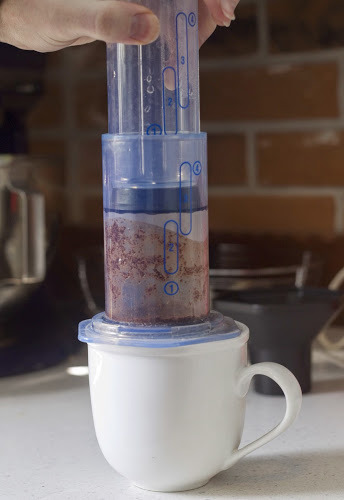


June 6, 2014
Killing With Kindness: X&HT Saw Swans
In 2002, I was was swimming in Australia when I was caught in a riptide.
We were in Perth, the most isolated major city in the world, on the penultimate day of a three-week tour of the south-western tip of the continent. In those days I swam a lot—I was strong and confident in the water. TLC watched from the beach as I romped in the surf.
Suddenly, I found that the current running parallel to the beach had strengthened, and I was unable to break free from it. I was smoothly swept down the line of the coast, away from my wife.
I knew better than to struggle or fight it. I would only exhaust myself against a force that had magnitudes more power than me. I allowed the tide to take me, nudging gradually forwards until, a quarter-mile upstream, I managed to reach a point where my feet touched sand again. I walked back, feet in the tide. It was an extraordinary moment, terrifying yet exhilarating. I knew that I had faced a force much greater than myself, and understood that my only sensible action, the only action that would permit my survival, was to surrender to it. To let it take me.
Last week, I saw Swans, and I had that feeling all over again.

The first thing people mention when they talk about Swans gigs is the volume. They eschew backdrops or projections: instead, when you see the stage on which they'll play, you're confronted with a jagged outcrop of amps. Mesa Boogies leaning on Marshalls. Oranges stacked on Trace Elliots. Swans mean business, and their business is to lose themselves and everyone along for the ride in the crescendo.
There's always been a Buddhist approach to the music. Long, long, looping drones and figures, a sound that mixes blues, motorik and the rattle of gamelan, building over the course of 20, sometimes 30 minutes, allowing you to lose yourself utterly in the sound. Meditative and all-consuming. When played through the wall of amps that Swans use you can feel yourself dissolving in it, becoming just another vibration in the hot, thick air of the club. As their t-shirts put it, “Imagine Total Annihilation”. That's not an aggressive stance in this context. It's about the dissolution of the self in the whole. As Gira says on the opening track of the new album, “No fear. No pain. No suffering.”
This is their time. From the furious post-punk primal proto-noise of their early years, to the blissed-out calm of The Drowning World, everything Michael Gira and Swans have done has been a progression, the slow slide of a tide up the beach. Since the reactivation of the band in 2010, their fearsome reputation and sheer muscular ability has brought them legions of new disciples, myself included. Their latest album, To Be Kind, has gone Top Forty. The audience at Reading's Sub89 last week, where I was lucky enough to catch them, was half indie-kids who were still at their mamma's tit when the first incarnation of the band was scaring the living daylights out of people.
Nowadays Swans understand. They know that you don't have to go full in from the starting bell, that sometimes you can lure people in, let the groove seduce them before unleashing the storm. Like Ali in round 8 of the Frazier fight, or a cat purring contentedly on your lap: things can change around fast at a Swans gig, and you never quite know when the teeth will show.
Let's talk about the sound. Swans are loud, and I say that as someone that's stood by the backline for a Reading festival headliner. In a small room like Sub89, the noise is a physical presence, moving your clothes around, thumping your chest, getting behind your eyes and filling you from every pore, from the outside in. There were free earplugs at the bar. I used them, and even so the monster blasting out from Swan's stacked amps was enough to cause concussion. They deserve their reputation. You don't approach a Swans gig unprepared. You dont face *that* without a modicum of preparation.
But noise is just noise. If you wanted to be battered by sound, you could go and stick your head into the business end of a jet engine. Over thirty-some years, Gira and his band have created something rare and wonderful—music bulging with aggression yet lyrically bruised and fragile. Swans deal with the notion of mankind facing a universe infinitely more vast, terrible and uncaring than is possible to imagine. I choose my words with care: Gira has a deep feel for what it is to be a man when faced with a world outside his command. In “Just A Little Boy (for Lester Burnett)” he jabbers, “I'm just…just a little boy” while mocking laughter boils up around him. Later, that jabber becomes a beefed-up roar—”I need LOOOOOOVE!” And yet, here again is the laughter, bubbling up like lava, burning away the disguise, the pretense. Meanwhile, in “Oxygen“, he recounts the time that an ashtma attack closed off his windpipe, leaving him moments from death, alone in his house, curled in a foetal ball, fighting for air. Swans are all about reconnecting with the simplest of human needs: to love; to breathe. It's primal, furious and welcoming all at once. The baring of teeth can be a warning, an attack or a greeting. It's all about how you approach it.
After the gig I stuck around, knowing that Gira would come out to greet fans and sign stuff. As he walked from backstage, resplendent in his signature white Stetson, I saw a man that has come to an understanding with the universe, a man comfortable in the realisation that there are forces greater than he. Although, as I shook his hand and felt the power there that comes from thirty years of slashing at a battered Gibson 335, I was at a loss to know just what could stand against him.
To Be Kind. What does that mean, in the context of what we've discussed? I believe that kindness comes from a realisation that we are all connected, that there are the same bones under our skin, the same blood in our veins. We are one, and to be unkind is akin to shoving a knife into our own flesh. That realisation often comes out of adversity: the way that a natural disaster will bear stories of people joining together, helping each other in the face of a storm. Kindness: of a kind. To Be Kind is to be human. A life without acts of simple humanity would be stark and bare as a hurricane-blasted tree. It is not in our nature to be unkind, and Gira and Swans see that clearly. There is cruelty in us, certainly. There is the capacity for evil. But it passes. It always does.
The universe is infinitely vast and cold, and filled with wonders and terrors beyond our understanding. All we can do as a species is to gather together, beat drums and howl at the sky. Sometimes, that's enough.



June 2, 2014
I Can Do Better, or The Tao Of Broth
It was The Leading Man’s birthday last week, and it was one of those occasions for which the phrase “the best laid plans” could have been written.
I won’t go into the full story; we’d be here for a while, and to be frank there are some stories that don’t need to be shared with the Readership at large. But there’s a detail apposite to the subject at hand that I should mention.
We were in a pan-Asian place whose USP is the ordering system. Touch pads and projections on the table turn ordering into a kind of clunky, retro-futurist game. This would be great if the food lived up to the playfulness of the general concept but, like a lot of West End eateries, the general experience was over-priced and underwhelming. Take my seafood noodle broth.
I couldn’t take umbrage with the description—it was indeed, a broth with seafood and noodles in it. It was full of fresh greenery and veg, the prawns and wontons were fine if severely rationed (two of each), but the whole thing just didn’t live up to expectations. I wanted something lively, zingy, bursting to life in my mouth. What I got was dull, insipid stuff. I left hungry and unsatisfied.
“By the gods”, I thought on the train home. The belligerance that comes from three pints of beer and a growly tummy settled on me like a cloak. “I could do better myself.”
Readership, that’s exactly what I did.
The star, the soul, the point to any soup or broth is the stock upon which it’s based. If that’s NFG, then so is the dish as a whole. For once, as I considered the options for the evening’s repast, I realised that I was already starting at a disadvantage—no decent stock in the house, godammit. However, there’s always Plan B, and one that’s appropriate to the mission. Miso.
As an emergency meal for those times when you can barely pull up the energy to boil a kettle, a sashet of miso paste is a genuine lifesaver. Pop in a mug, hot water over the top, and you have soup in the time it takes to make a coffee. Here, again, it would prove to save the day.
Two sachets of miso paste, then, dissolved into about 600ml of water to create a stock that has a pleasing thrum of umami without too much salt. Good start. Now for some veg. I unsheathed my cleaver and got choppin’.
Garlic, a couple of cloves. Ginger, a thumb. Chilis, two bird’s eye. Three decent spring onions (the red ones in the shops now are sweet, mild and delicious) half a red pepper and a couple of sticks of celery. The first three, fine dice. The last three, fine slice. The lot went into a hot stock pot, which had a little oil in the bottom. I let it all sizzle for a coupe of minutes, then hoiked the veg out, and added a sliced jumbo chicken thigh.
Yes, chicken. The point where this stopped being a seafood noodle broth was the point that I realised I didn’t have that much seafood in the house. Some raw prawns and er that’s it. “Divergence”, thought I. “You cook for no-one’s pleasure but thine own. Go with the chicken.”
Sod it, I went with the chicken. Five minutes each side, enough to get the chicken browned and a little extra fat (because as we all know, fat means flavour, thank you Hairy Bikers) in the pan. Good smells wafted up and I began to think that I’d got this right.
I threw the veg back into the pan for a few moments, letting everything sizzle and pop. Then the stock on top, in a swoosh of amber. I turned the heat down, clapped on a lid, and poured myself a glass of the Wine Of Victory (Rioja, in case you’re wondering). Bubble, simmer. Amazing smells. 15 minutes to chow time.
With 5 minutes to curtain up, I finished the broth. In went the prawns, which I’d marinaded in lime juice and salt and were therefore almost cooked already, the noodles (yes, ok, they were stirfry egg noodles, but they were what I had) and the juice of a lime. Oh, and, in a moment of inspiration, some samphire that had been guilt-tripping me from the depths of the fridge ever since I’d bought it. To the broth with you, weird seaweedy stuff.
Once the prawns had firmed and the noodles were soft, we were good to go. Into deep soup bowls with a handful of coriander on top, and to the table with me.
Oh my gods it was good. Pungent, deeply flavoured, full of interesting bits and bobs. I’d worried about the samphire tipping the salt balance the wrong way, but my fears were groundless. If anything, it gave the broth the final seasoning hit it needed. TLC and I both scoffed a bowlful in happy silence.
Better yet, there was enough to eat for dinner the following day. The stock had intensified, the chili hit becoming more noticable. I goosed things up with some pancetta, fried off in a hot pan before I poured in the leftovers, and more coriander, this time added as part of the cooking process rather than a garnish. Served with some toasted sourdough on the side, the broth was as far from authentic as it gets. But boy, was it ever good eating.
I’m always looking for inspiration as a cook, whether it be from recipes I stumble over on the internet or in cookery books, or meals I’ve eaten, or just that desperate point where I’m staring at a half-open fridge and the unexpected confluence of two ingredients strikes a spark which leads to dinner. But the notion of being inspired by a disappointing meal is something new, and one that bodes well for the future. Here’s a challenge for you. Next time you’re served a meal in a restaurant that isn’t that great, see if you can do any better. You might just surprise yourself.


May 30, 2014
Killing Logan
Superheroes are notorious for not staying dead.
No matter how hard the writers and editors try, there's always the bottom line to worry about. How long can you have Superman comics without Superman? Dick Grayson can wear the cape for a while, but we all know Batman's secret identity, and it ain't no damn ward. Some heroes are on their third or fourth trip round the block, out of the cemertary and back on the streets. The worst offenders in the resurrection stakes have to be The X-Men.
I've lost count of the times that Jean Grey has been buried, and the recent X-Men: Days Of Future Past has made a virtue out of quietly returning Professor X to the chair–quite a feat even for a film whose modus operandi is to wipe the slate clean and sweep any inconvenient plot wrinkles under the carpet.
But how about James Logan Hewlett, The Wolverine? His X-gene healing powers make him well-nigh immortal and invulnerable. He's been pretty much flensed down to the adamantium-laced bone and still managed to come back swinging.

So, with how many pinches of salt should we take the announcement that Logan is to be killed off this autumn? Doctor Who writer Paul Cornell has already stripped the guy of his healing powers–now he's just a guy with a weaponised skeleton. The inevitable is only a matter of time.
We've been here before, of course. The iconic cover to the second issue of Days Of Future Past lays it out before you even get to page one. Logan caught in a Sentinel's repulsor blast, shredded to dog-chow, while the text breakout makes it even more starkly clear; “This Issue: Everybody Dies!” And so he does, although five pages later he's back on his feet, as Kitty Pryde fixes the timeline and restores the balance. In the world of comics, the mantra is always “same as it ever was.”

In volume three of his own title, Logan ends up in hell after sustaining injuries too serious for his healing factor to deal with. Even that isn't enough to stop the guy: he simply beats Azreal, the Angel of Death into submission. If hell can't stop him, then what can?
Well, let's consider that. He couuld potentially die by drowning, especially with the extra weight of his adamantium skeleton dragging him down. Another form of unobtania, the rare metal carbonadium, is also capable of radically slowing Logan's healing factor, as is the mystical Muramasa blade. Over the years, though, writers have amped up his powers to the extent that Wolverine has survived the full blast of an atomic explosion, and having all his soft tissue ripped away (so much for that Sentinal's repulsor blast). The guy just doesn't know when to call it a day.
His abilities have even fitered into the world of science. His regenerative powers have been studied by the University of Columbia, who compared him to the axolotl, a reptile that can regrow severed limbs. They theorised that a protein similar to Amblox, which is found in the reptile's soft tissues, could be the cause of his signature way of shrugging off an owie.
OK, let's get real here. Wolverine may die, but he's not going to stay dead. There's too much of a vested interest in the character. He's in a heaping double-handful of current books, including a membership to The Avengers. He's one of the most popular, recognisable comics characters on the planet. Killing him is sadly little more than a stunt, and reader interest is, like the deaths of major figures before him, as much about his inevitable return and how it's pulled off.
Bub, you don't kill Wolverine. He's just too darn good at what he does.



May 28, 2014
“Koftas” and “Tzatziki”
A recent discussion about authenticity in food banging about on Twitter got me thinking.
Traditional grub, cooked a certain way since time immemorial, has its place. It’s tough to beat a proper Irish stew, a Margherita pizza, or paella sizzing in the plancha. The notion of fancying up those pure, simple flavours is tantamount to heresy to many people.
Fair enough. But then the kitchen has always been a place of experimentation, where you’re entitled to muck about, to play with your food. Lest we forget, many of our favourite meals were created out of a moment of inspiration, moving away from the holy text of the cookery book. Curry, for example, made for the first time by a chef on a train to Lucknow in the 1860s, faced with a demanding customer who thought his mutton was just too dry. In fact, many British tea-time favourites are bastardisations of regional cooking. Spag bol? Italians would never eat a ragú with round noodles.
There are times when you have to work with what you have and what your heart and belly are telling you to cook. Those inspired moments are when your food can really shine. Hence the quote marks in the title to this piece. The dinner I cooked after a day’s gardeneering isn’t really a Turkish specialty at all. But that, Readership, is how I roll when it comes to whipping up something good to eat.
Start with lamb mince, 500g for two hungry gardeneers. I toasted up a teaspoon of cumin and another of coriander seed in a dry pan until they wafted warm fragrance around the kitchen. Then I smacked them around in my mortar into a fine powder. Yes, you can use a spice grinder. But I like doing a percussion solo with my toasted seeds. Add some paprika, a little finely chopped ginger and a couple of cloves of garlic. I had a head of smoked garlic, which I’d roasted the day before until it went soft and unctuous. Ordinary is fine, but if you get a chance to cook some off beforehand, it does make a difference.*
Now grab some herbs. Mint and oregano, perhaps some thyme. Parsley, fur shure. Grab loads of mint. Chop finely (again, I go old school with a blade, but there’s nothing wrong with a quick blast in the Magimix or even Jack Monroe’s scissor and tea-cup method. Like I say, whatever works for you). Put half the mint and a little of the herb mix to one side for the Tzatziki and further shenaniga further down the road.
Now, add your herbs and spices to the mince, and mix well. Use your hands. Get squishy with it.
When everything’s incorporated, take a palmful of spiced meat, roll into a ball, then shape it down into a small patty. You should get 8 out of the mixture. Pop ‘em on a tray, cover and let them rest while you get on with the sauce. May as well get a pan hot on the stove, cos this next bit won’t take long.
I’ve never been quite sure of the difference between tzatziki and cucumber raita, so I use the same recipe and just change the name depending on what it’s going with. Call it Rob’s All-Purpose Mint, Yoghurt and Cucumber Sauce if you like. That’s pretty much the recipe right there.
Into half a big pot of natural yoghurt, mix in mint, some grated and squeezed-out cucumber, a finely chopped spring onion, and a little salt. Maybe some capers if you’re in the mood for an extra pop of flavour. Done. Pop in the fridge. Time to fry your koftas.
You notice my koftas aren’t sausage shaped and on skewers. Why? Well, I don’t have enough skewers, for one thing. For another, they’re easier to fry in a pan in a patty form. For a third, they fit better into a pita shaped like that. I point you again at the inverted commas in the title.
Aaaanyway. Hot non-stick pan or griddle. No extra oil. This is lamb, don’t forget, and perfectly capable of lubricating itself. Pop in as many koftas as will fit in a single layer, without crowding. With a big enough pan, you should be able to do the lot in one go. Five minutes a side, please. Resist the tempation to fiddle. In fact, while the koftas are developing that delicious favoursome crust, there’s one last bit of business.
Take the reserved herbs from earlier, and grate over a lemon’s worth of zest. If you have the energy, a little veeeery finely chopped garlic and chili would be nice too. Done? Great. Now you can turn your koftas.
While they’re on the second half, warm through a few pitas under a grill. They go straight onto your serving plates.
Assembly time. This may be over-stating the obvious, as by “assembly” I mean “put on plates.” Pile your koftas up attractively, and sprinkle over your herb and lemon finishing mix. Big dollop of tzatziki on the side. Eat with a cold beer, a crisp green salad or maybe some potato wedges if you’re feeling greedy.
Like I say, completely untrad, but totally delicious. Authentic is fine, but in my kitchen, things get done my way.
*Roasting garlic? Couldn’t be easier. Chop off the pointy bit to expose the top of the cloves. Cradle in a scrunched sheet of foil, then pour over a little oil, grind on some seasoning, and perhaps a little wine. Wrap up firmly, and stick in a hot oven for half an hour. Leave to cool. Squishy, mellow, deeply flavoured.



